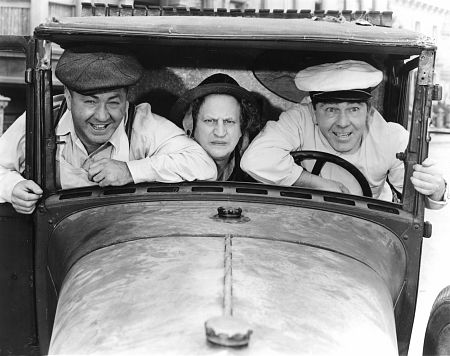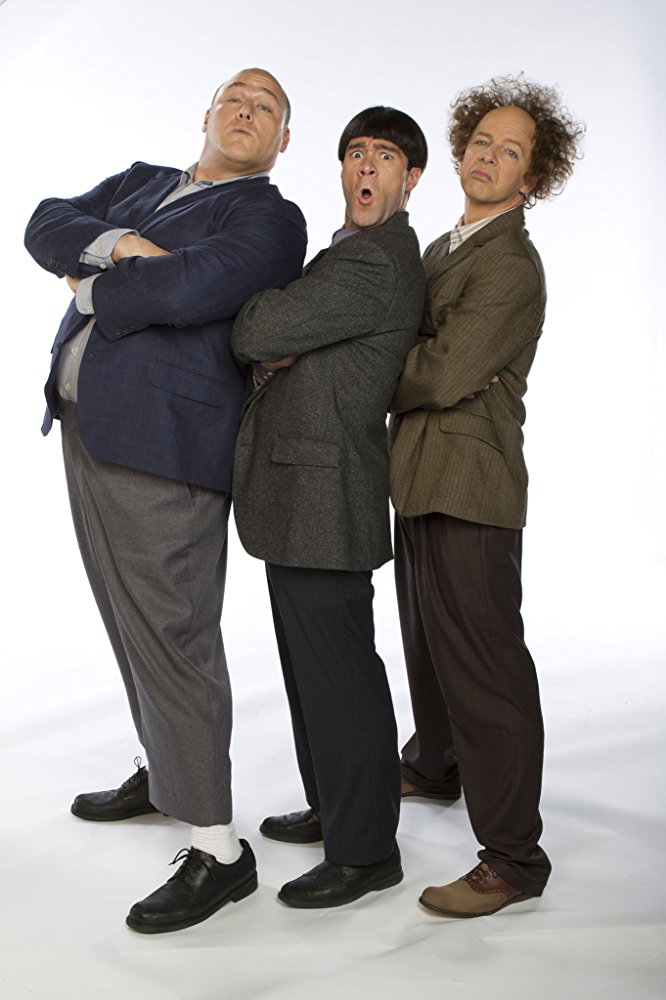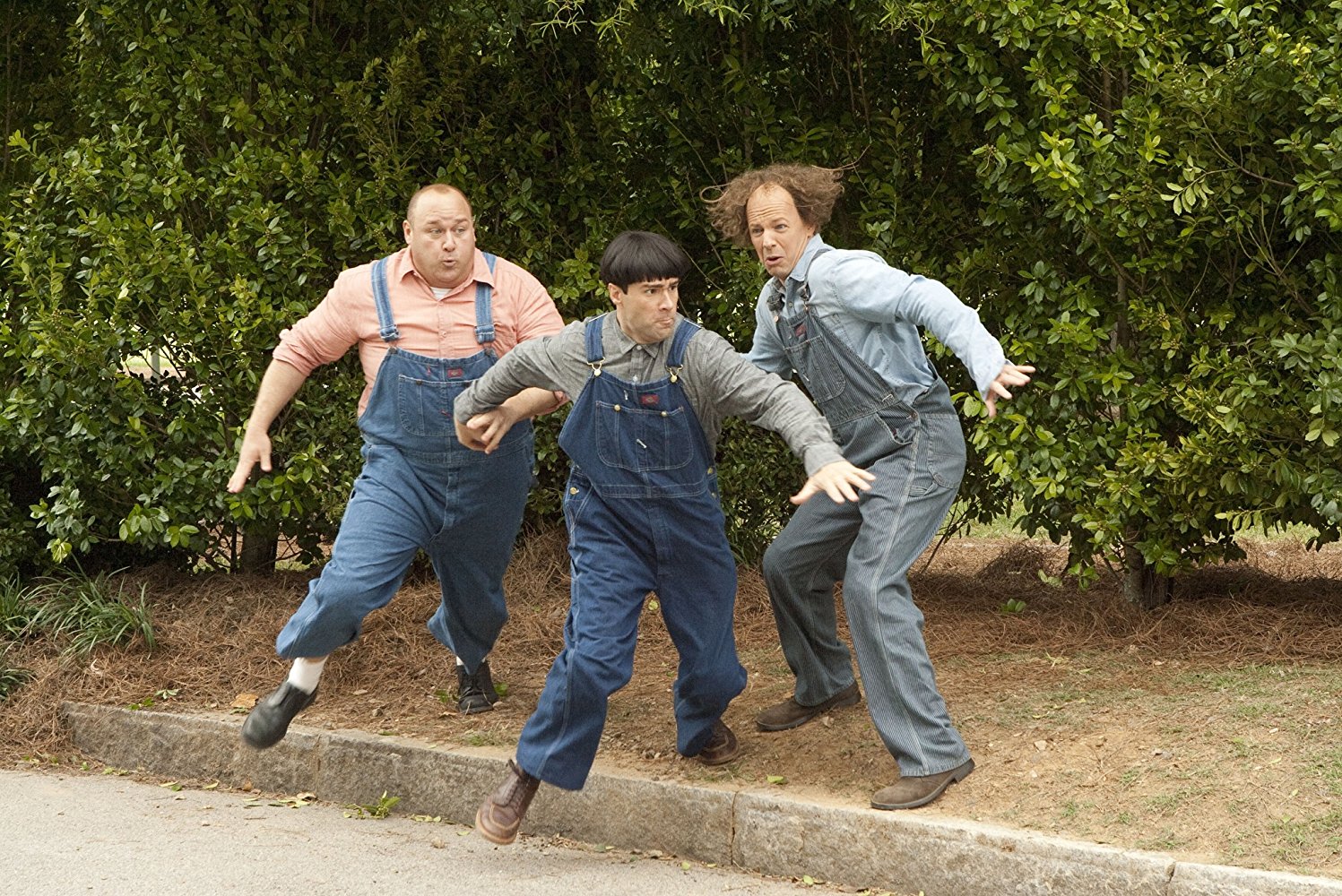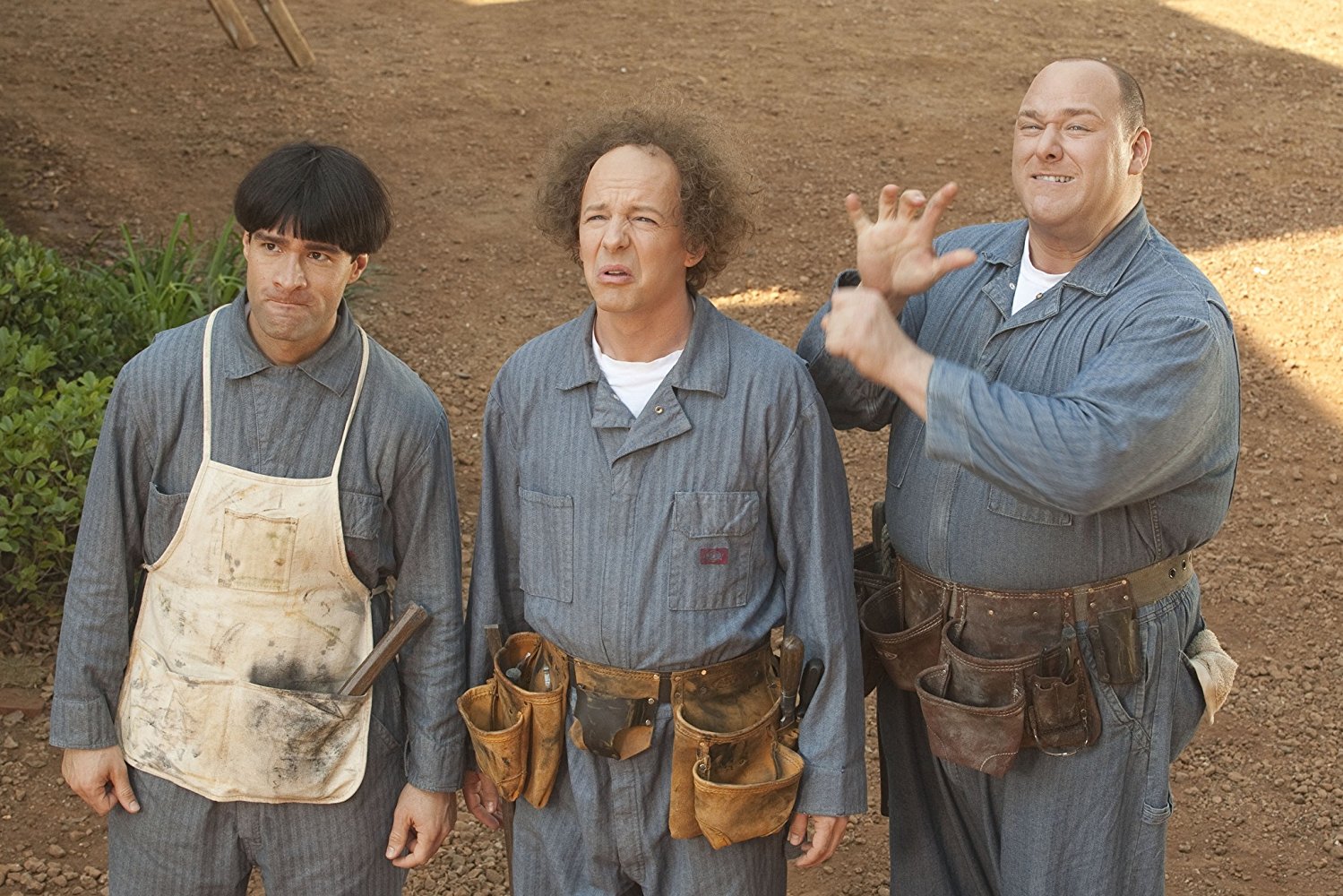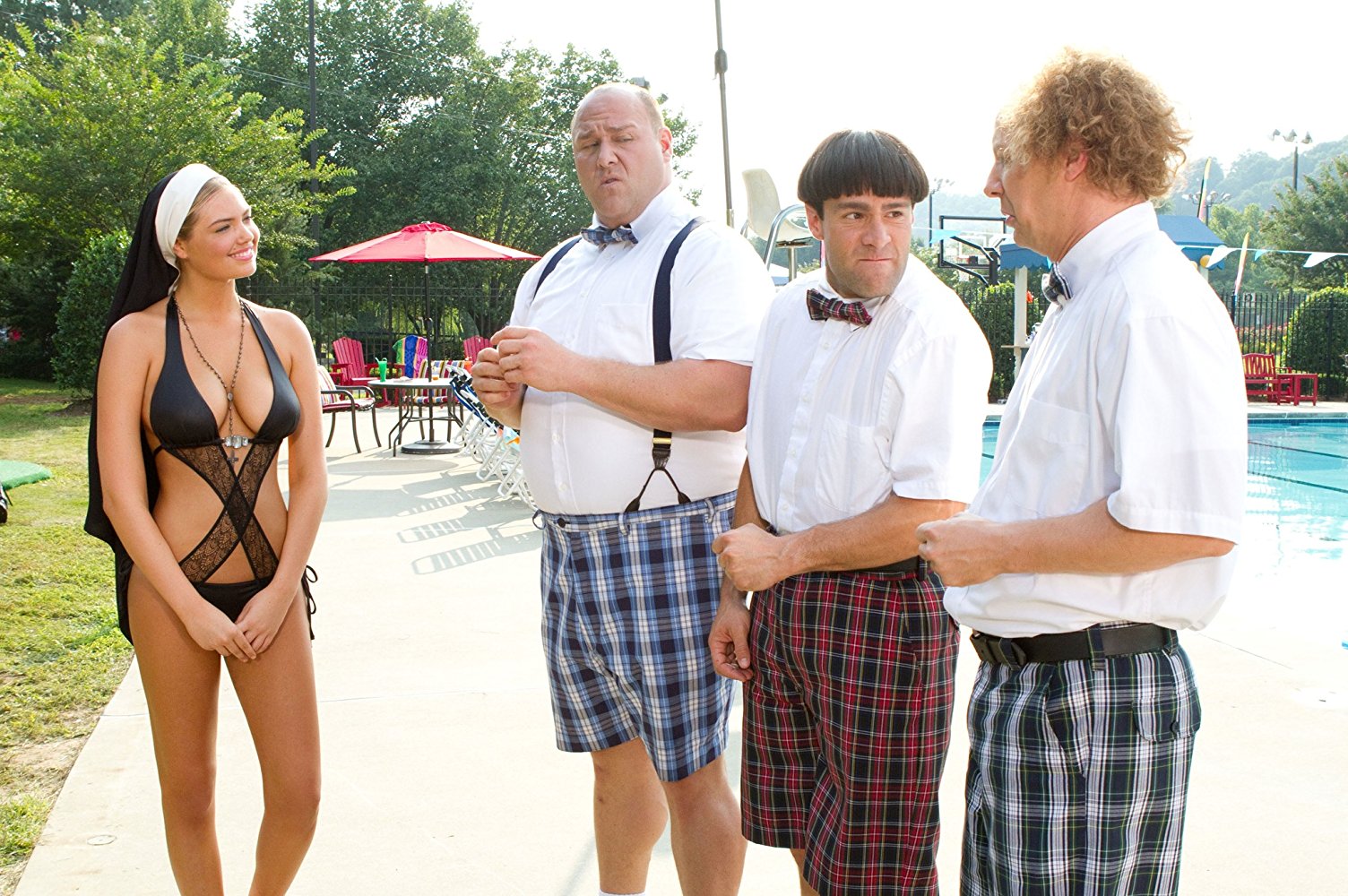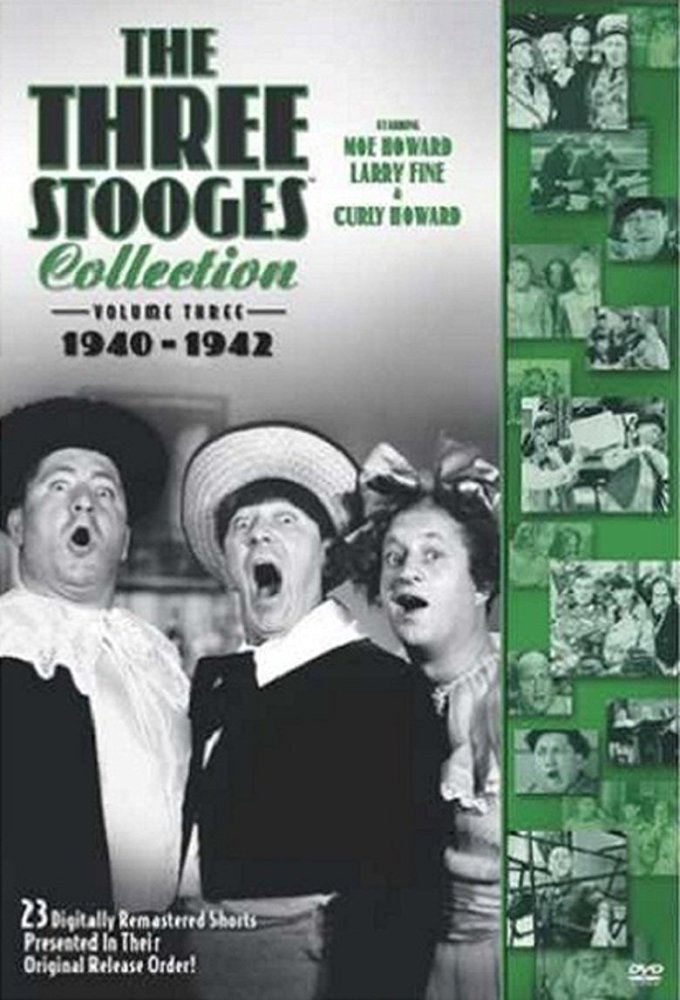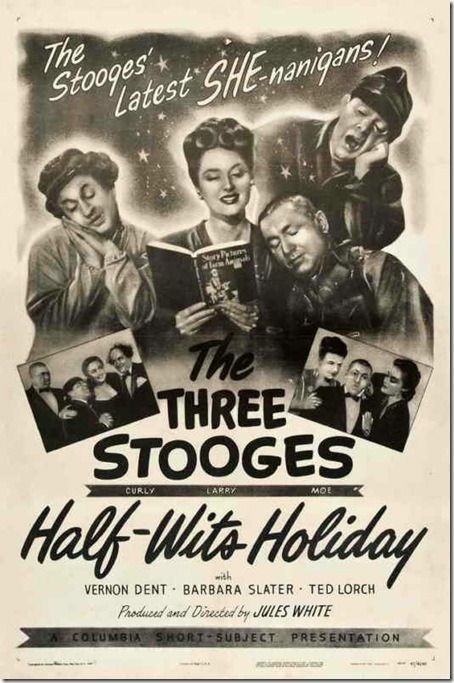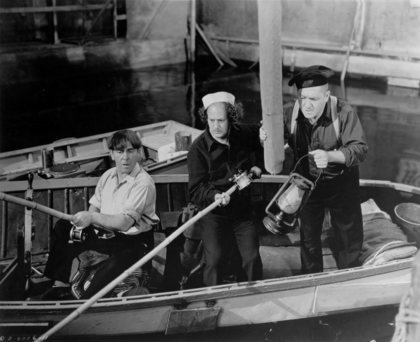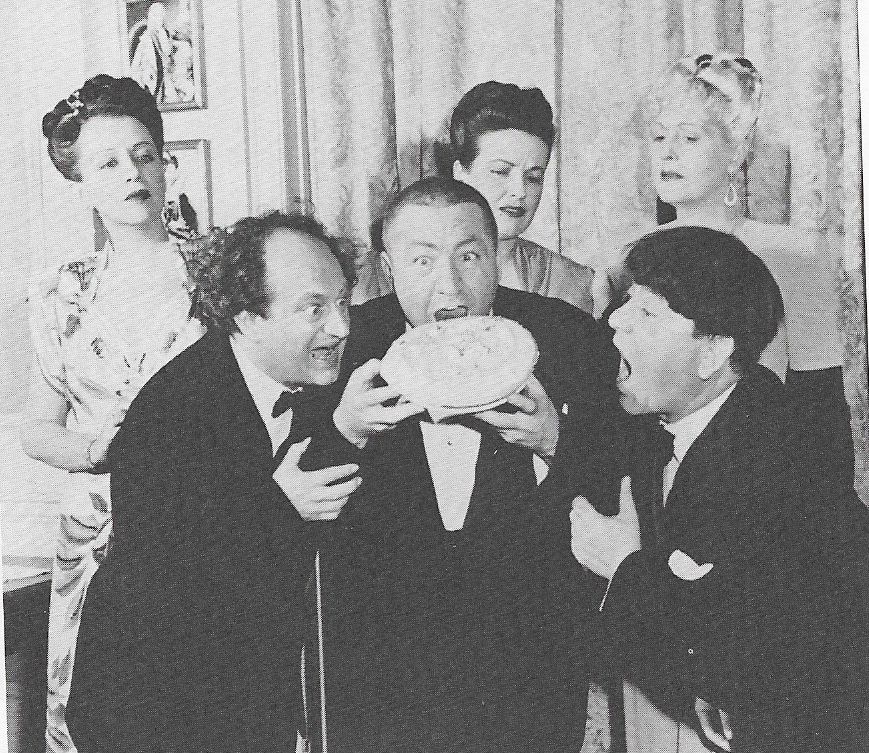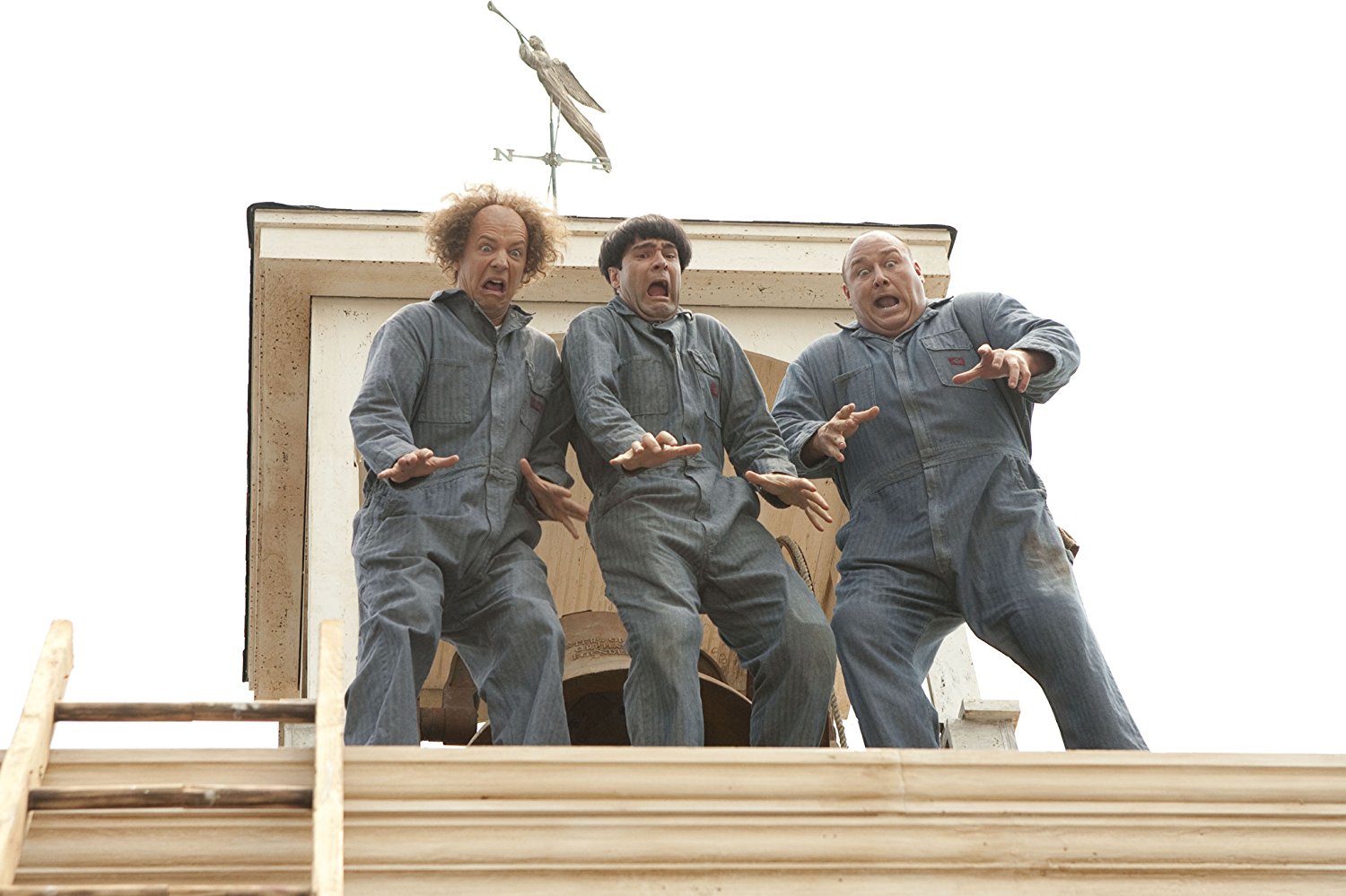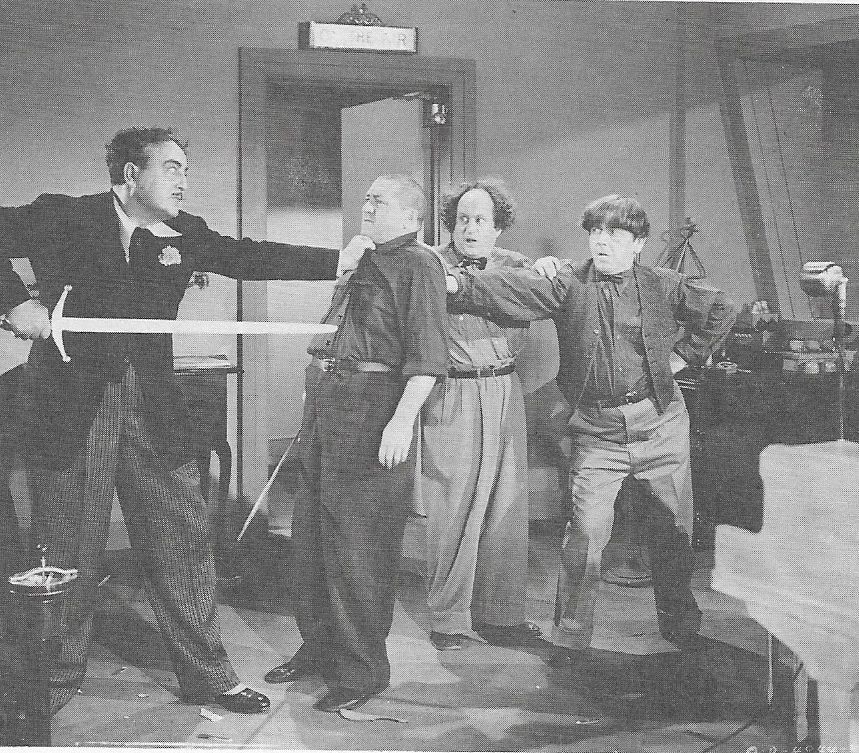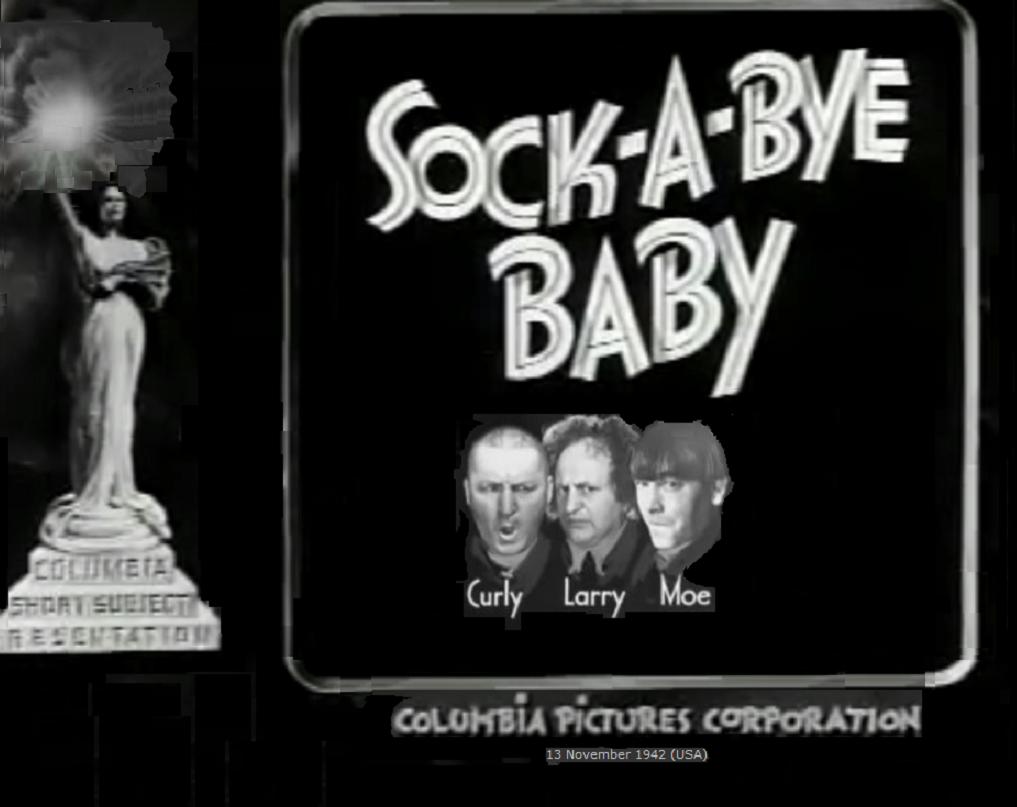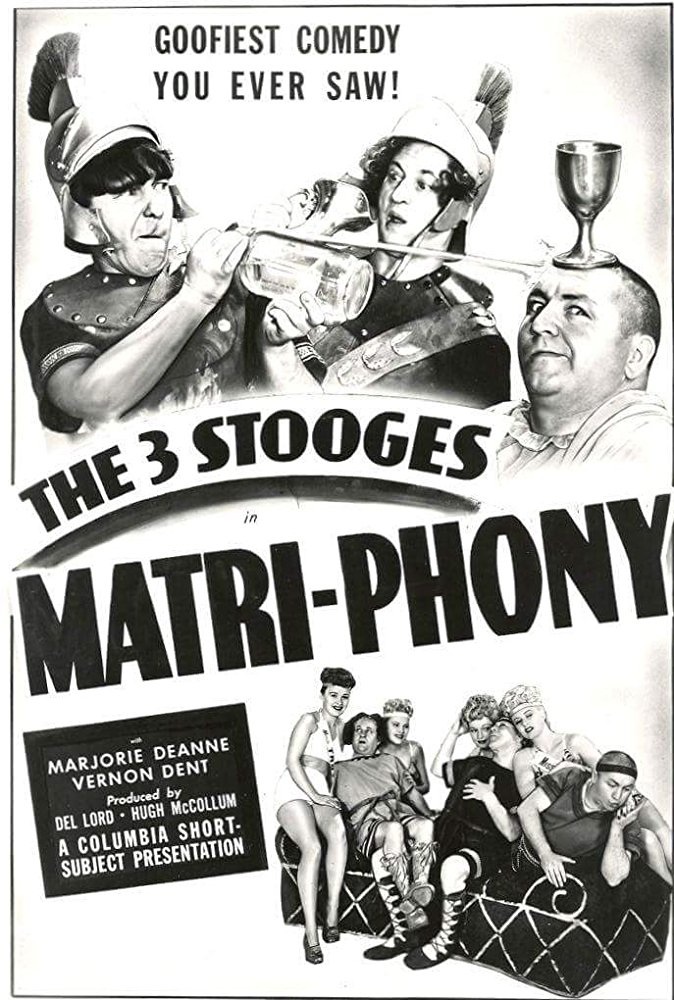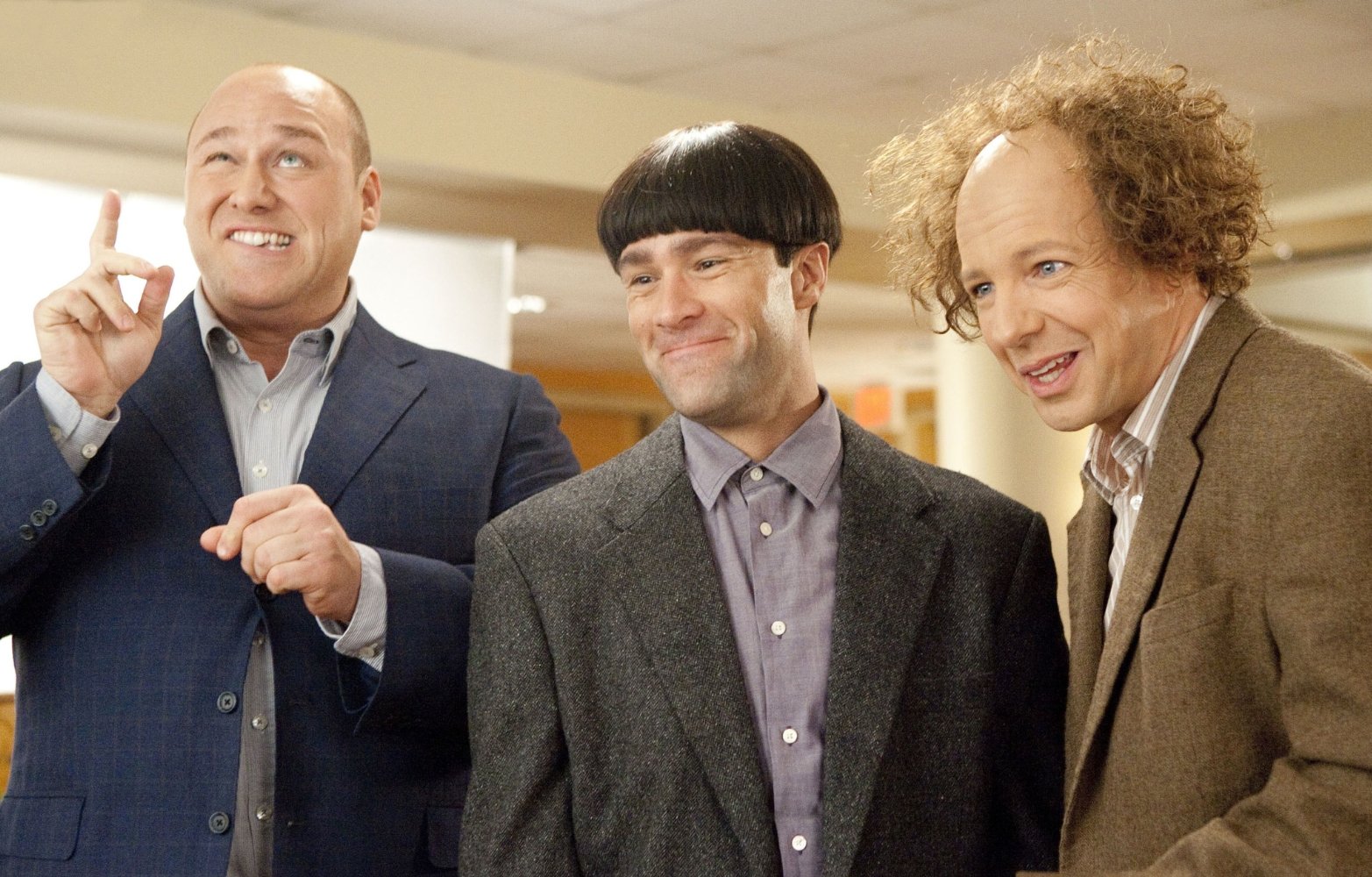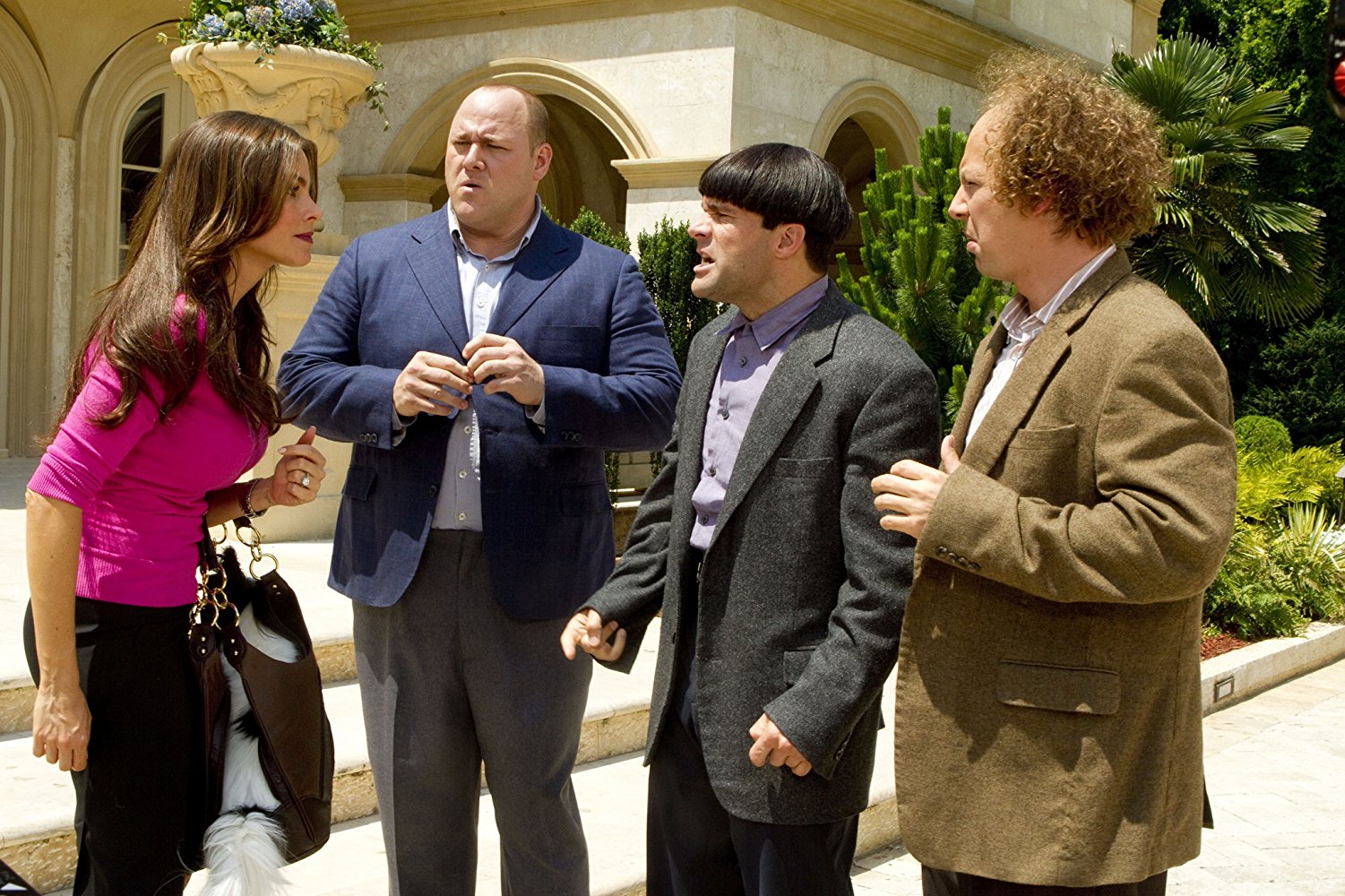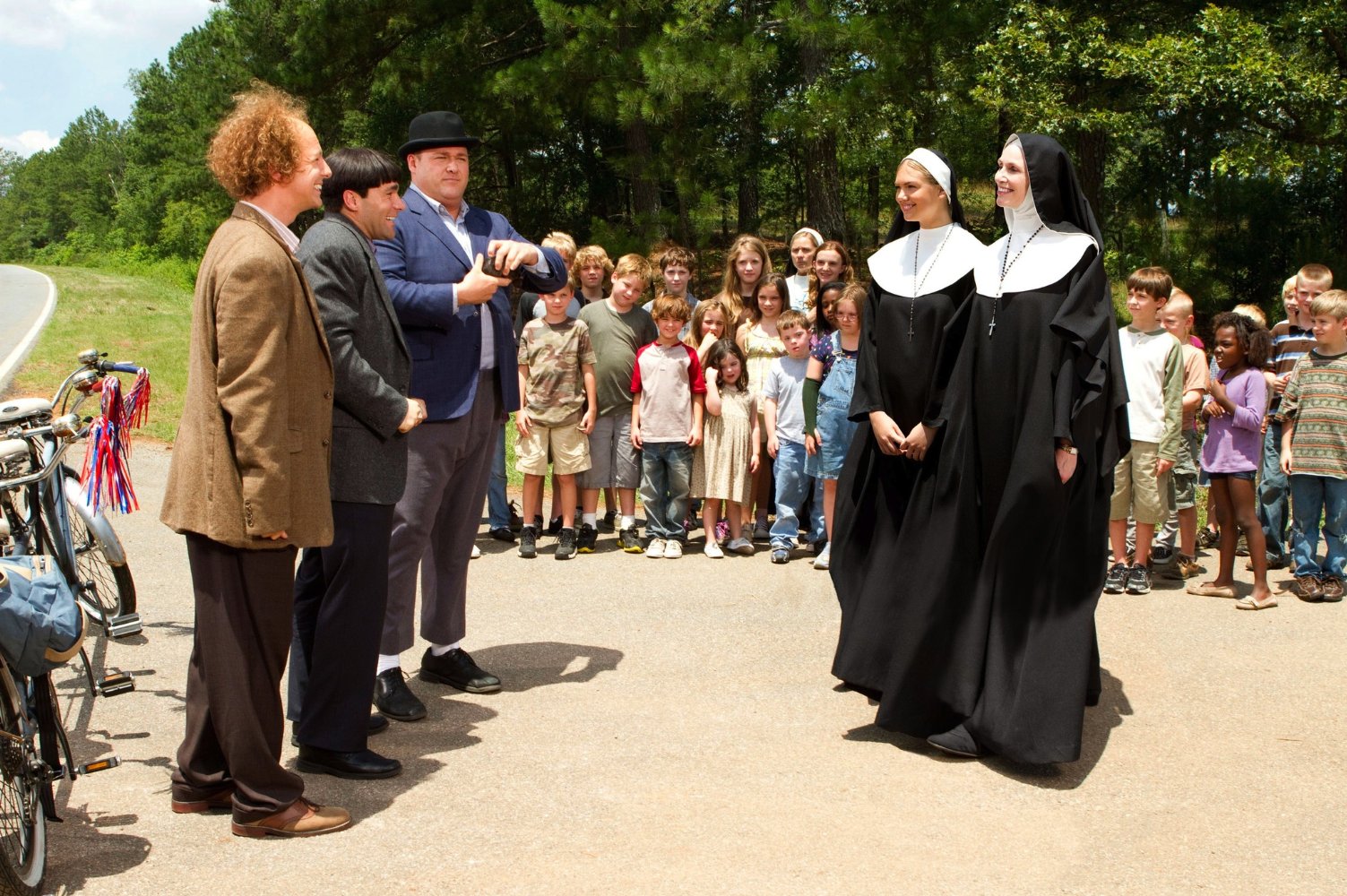Jerome Lester Horwitz Born: October 22, 1903(1903-10-22) Brownsville, Brooklyn, New York Died: January 18, 1952 (aged 48) San Gabriel, California,Other name(s): Curley Howard Jerry HowardSpouse(s) Julia Rosenthal (1930) Elaine Ackerman (1937-1940) Marion Buxbaum (1945-1946) Valerie Newman (1947-1952)Curly Howard (October 22, 1903 January 18, 1952) was an American comedian and vaudevillian, best known as a member of the American slapstick comedy team the Three Stooges, along with his older brothers Moe Howard and Shemp Howard, and actor Larry Fine. Curly is generally considered the most popular and recognizable of the three. He is well known for his high-pitched voice, vocal expressions ( nyuk-nyuk-nyuk! and woo-woo-woo! ), as well as his inventive physical comedy, improvisations, and athleticism.An untrained actor and natural comedian, Curly borrowed (and significantly exaggerated) the woo woo from nervous and soft-spoken comedian Hugh Herbert, but was otherwise an original and inspired performer. Curly's unique version of woo-woo-woo was firmly established by the time of the Stooges' second film Punch Drunks in 1934.Curly was born Jerome Lester Horwitz in Brownsville, a section of Brooklyn, New York. He was the fifth of the five Horwitz brothers and of Levite and Lithuanian Jewish ancestry. Because he was the youngest, his brothers called him Babe to tease him. The nickname stuck with him all his life, although when Shemp married Gertrude Frank, who was also nicknamed Babe, the brothers started calling him Curly to avoid confusion. His full formal Hebrew name was Yehudah Lev ben Shlomo Natan ha Levi. A quiet child, Curly rarely caused problems for his parents (something older brothers Moe and Shemp excelled in). The shy Howard brother was a mediocre student academically, but excelled as an athlete on the school basketball team. He did not graduate from high school, but kept himself busy with odd jobs and constantly followed his older brothers whom he idolized. The graceful Stooge was also an accomplished ballroom dancer and singer, and regularly turned up at the Triangle Ballroom in Brooklyn, occasionally bumping into George Raft.When Curly was 12, he accidentally shot himself in the left ankle while cleaning a rifle. Moe rushed him to the hospital and saved his life. The wound resulted in his leg being noticeably thinner, and he also suffered a slight limp. Curly was so frightened of surgery that he never got the limp corrected. While with the Stooges, he developed his famous exaggerated walk to mask the limp on screen.Curly was interested in music and comedy, and would watch his brothers Shemp and Moe perform as stooges in Ted Healy's vaudeville act. Curly also liked to hang around backstage, though he never participated in any of the routines.Early career and the Three Stooges From an early age, Curly was always in demand socially, as brother Moe put it. He was also a ladies' man and could not resist a beautiful woman. Curly married his first wife, Julia Rosenthal, on August 5, 1930. The two divorced shortly afterwards.In 1928, Curly's break onto the stage was as a comedy musical conductor for the Orville Knapp Band. Moe later recalled that Curly's performances usually overshadowed those of the band. Though Curly enjoyed the gig, he watched as older brothers Moe and Shemp (and partner Larry Fine) made it big as one of Ted Healy's stooges. Vaudeville star Ted Healy had a very popular stage act, in which he would try to tell jokes or sing, only to have his stooges wander on stage and interrupt him. By 1930, Healy and company appeared in their first feature film, Rube Goldberg's Soup to Nuts.Shemp, however, never liked Healy's abrasiveness and drunken bouts of anger. In 1932, luck came Shemp's way, when he was offered the role of Knobby Walsh in the Joe Palooka series, produced by Vitaphone back in Brooklyn. Shemp was thrilled to be away from Healy, but, as was his nature, worried incessantly about brother Moe and partner Larry. Moe, however, told Shemp to pursue this opportunity:In 1932, Shemp got the opportunity to play the character Knobby in Joe Palooka pictures out on the coast. And it seemed like a great opportunity for Shemp. And he was reluctant about leaving, he said, 'Well, what are you gonna do for a third man?' I said, 'Shemp, don't worry about that. Grab your opportunity and we'll get the kid brother Curly in.' And Curly was working with a band called Orville Knapp and his Band, he was a comedy guest conductor. And it got a big laugh, so we got in touch with Curly and said, 'Give your man two weeks notice and come on, you're gonna join with us.With Shemp gone, Moe suggested that kid brother Jerry fill the role of the third stooge. However, Ted took one look at Jerry, with his chestnut-red locks and elegant waxed mustache and stated that he was not a funny character like Moe and Larry. Jerry left the room and returned minutes later with a shaved head and face. Healy quipped, Boy, don't you look girlie? Moe misheard the joke as curly and all who witnessed the exchange realized that the nickname Curly would be a perfect fit. In one of the few interviews Curly gave in his lifetime, he moaned about the loss of his beloved mane: I had to shave it off right down to the skin. In 1934, MGM was building Ted Healy up as a solo comedian in feature films and Healy dissolved the act to pursue his own career. Like Shemp, the team of Howard, Fine and Howard were tired of Healy's alcoholism and abrasiveness and renamed their act the Three Stooges. The same year, they signed on to appear in two-reel comedy short subjects for Columbia Pictures. The Stooges soon became the most popular short-subject attraction, with Curly playing an integral part in the trio's rise to fame.Prime years By the end of the 1930s, Curly was clearly the star of the Three Stooges. His childlike mannerisms and natural comedic charm made him a hit with audiences. Having no formal acting training, his comedic skill was entirely spontaneous. Many times, directors would simply let the camera roll to see what Curly came up with. Jules White, in particular, would leave gaps in the Stooge scripts where Curly could improvise for several minutes. By time the Stooges hit their peak in the late 1930s, films had almost become vehicles for Curly's unbridled comic performances. Classics like A Plumbing We Will Go, We Want Our Mummy, An Ache in Every Stake and Cactus Makes Perfect display Curly's innate ability to take inanimate objects (like food, tools, pipes, etc.) and turn them into comic genius. Moe later confirmed that the fact that Curly often forgot his lines only allowed him to improvise on the spot rather than ruin the shot: If we were going through a scene and he'd forget his words for a moment, you know. Rather than stand, get pale and stop, you never knew what he was going to do. On one occasion he'd get down to the floor and spin around like a top until he remembered what he had to say.Curly also developed a set of reactions and expressions that the other Stooges would imitate long after he had left the act: * N'yuk, n'yuk, n'yuk - often used when Curly had amused himself * Woo, woo, woo - used when he was either scared or flirting with a dame * N'gahh! - scare reaction (this was the most-oft used reaction by the other Stooges after Curly's departure * Ruff, ruff - a dog bark, used to give an enemy a final push before departing the sceneOn several occasions, Moe was convinced that rising star Lou Costello (a close friend of Shemp) was siphoning material from Curly. Costello was known to acquire prints of the Stooges' films from Columbia Pictures on occasion, presumably to study Curly. Inevitably, Curly's routines would show up in Abbott and Costello features, much to Moe's chagrin (it did not help that Columbia Pictures president Harry Cohn would not give the Stooges a chance to make feature-length films like contemporaries Laurel and Hardy, the Marx Brothers and Abbott and Costello).Oddly enough, Curly's offscreen personality was the antithesis of his onscreen manic persona. An introvert, Curly generally kept to himself, rarely socializing with people unless he had consumed several drinks. In addition, he came to life when in the presence of brother Shemp. Curly could not be himself around brother Moe, who treated his younger brother with a fatherly wag of the finger. Never an intellect, Curly simply refrained from engaging in crazy antics unless he was in his element: with family, performing, or slightly intoxicated.On June 7, 1937, Curly married Elaine Ackerman, who gave birth to Curly's first child, Marilyn, the following year. The couple divorced in 1940. After this divorce, Curly gained a tremendous amount of weight and developed hypertension. The fact that Curly always believed that his shaved head made him unappealing to women caused him to drink excessively to mask his insecurities. As such, he took to wearing a hat in public to convey an image of masculinity, saying he felt like a little kid with his hair shaved off. However, he was popular with women all his life. In fact, many who knew him said women were Curly's main weakness. Moe's son-in-law Norman Maurer even went so far as to say he was a pushover for women. If a pretty girl went up to him and gave him a spiel, Curly would marry them. Then she would take his money and run off. It was the same when a real estate agent would come up and say 'I have a house for you,' Curly would sell his current home and buy another one. During World War II, for seven months out of each year, the trio's filming schedule would go on hiatus, which allowed them to make personal appearances. The Stooges entertained servicemen constantly, and the intense work schedule took its toll on Curly. Curly never drank while performing in film or on stage, as Moe would not allow it. However, once away from Moe's watchful eye, Curly would find the nearest nightclub, down a few drinks, and enjoy himself. His drinking, eating, and carousing increased. He had difficulties managing his finances, often spending his money on wine, food, women, homes, cars, and especially dogs and was often near poverty. Moe eventually handled all of Curly's financial affairs, helped him manage his money, and even completed his income tax returns.Curly found constant companionship in his dogs and often befriended strays whenever the Stooges were traveling. Curly would pick up homeless dogs and take them with him from town to town, until finding them homes somewhere else on the tour. When not performing, Curly would usually have a few dogs waiting for him at home as well.Slow decline By 1944, Curly's energy began to wane. Films like Idle Roomers, The Yoke's on Me and Booby Dupes present a Curly whose voice was deeper and his actions slower. After the filming of Idiots Deluxe, Curly finally checked himself into Cottage Hospital in Santa Barbara, California on January 23, 1945 and was diagnosed with extreme hypertension, a retinal haemorrhage and obesity. It is also believed that Curly suffered the first in a series of mild strokes at this time. Moe pleaded with Harry Cohn to allow Curly some time off upon discharge to regain his strength. Unfortunately, Cohn would not halt the production of his profitable Stooge shorts and flatly declined Moe's request. Author Michael Fleming later stated that ...it was a disastrous course of action. The first film produced after Curly's stroke was the lackluster If a Body Meets a Body, and Curly's actions and mannerisms were noticeably slower. In the hands of a sympathetic director like novice Edward Bernds, Curly could produce decent work. This was because Bernds' painstakingly devised ways that the ailing Stooge could still be the star without actually contributing a great deal. Films like Monkey Businessmen (in which Curly had to be coached by Moe on camera), Micro-Phonies and A Bird in the Head were fine examples of Bernds factoring in the reality that Curly was no longer in his prime. Other directors, such as Jules White, simply shifted the action to Moe and Larry. Films like Beer Barrel Polecats and Uncivil War Birds were mediocre at best and clearly showed that Curly was suffering.Subsequently, Moe urged Curly to find himself a wife, hoping it would convince his brother to finally settle down and allow his health to somewhat improve. After a two-week courtship, Curly married Marion Buxbaum on October 17, 1945, a union which lasted approximately three months. The divorce proceeding was a bitter one, exacerbated by exploitation in the local media. After this divorce, Curly's health began a rapid and devastating decline.Illness By early 1946, his voice had become twice as coarse as before, and he had increasing difficulty remembering even the simplest dialogue. He had lost a considerable amount of weight and lines had creased his baby face. The quality of his performances seriously declined, as his strength and energy plummeted his final 12 films become the nadir of a once-bright career.Two of Jules White's effortsThree Loan Wolves and Rhythm and Weepclearly display a sick Curly as indicated by his much slower movements. Ed Bernds, however, was lucky enough to capture the ailing Stooge on an up day when filming Three Little Pirates. Curly seemed better and there was some hope that his illness was finally under control. I guess I should be thankful that Curly was in one of his 'up' periods, Bernds said later. In Three Little Pirates, he was terrific. It was the last flash of the old Curly. On May 6, 1946, while filming Half-Wits Holiday, Curly suffered a massive stroke on the set. Curly soon took residence at the Motion Picture Country Home and Hospital in Woodland Hills, California.Curly had to leave the team to recuperate. Shemp returned to the trio, to replace Curly in the Columbia shorts; an extant copy of the Stooges' 1947 Columbia Pictures contract was signed by all four Stooges and stipulated that Shemp's joining in place and stead of Jerry Howard would be temporary, until Curly recovered sufficiently to return to work full time. During the last two years of Curly's career, Shemp had been recruited occasionally to substitute for Curly during live performances; now the replacement became permanent.Curly made a brief cameo appearance (doing his barking-dog routine), in the third film after brother Shemp returned to the trio, Hold That Lion!. It was the only film that featured Larry Fine and all three Howard brothers, Moe, Shemp and Curly, simultaneously; director Jules White later said he spontaneously staged the bit during Curly's impromptu visit to the soundstage: It was a spur of the moment idea. Curly was visiting the set; this was sometime after his stroke. Apparently he came in on his own, since I didn't see a nurse with him. He was sitting around, reading a newspaper. As I walked in, the newspaper, which he had in front of his face, came down and he waved hello to me. I thought it would be funny, to have him do a bit in the picture and he was happy to do it.Curly filmed a second cameo as an irate chef two years later for the short Malice in the Palace, but his scenes were eventually cut. A lobby card for the short shows Curly with the other Stooges, though he never appeared in the final product.Retirement and happy marriage Still not fully recovered from his stroke, Curly met Valerie Newman, whom he married on July 31, 1947. A friend later recalled, Valerie was the only decent thing that happened to Curly and the only one that really cared about him. Although his health worsened after the marriage, Valerie gave birth to a daughter, Janie, in 1948.Later that year, Curly suffered a second massive stroke, which left him partially paralyzed. He was confined to a wheelchair by 1950 and was fed boiled rice and apples as part of his diet to reduce his weight. Curly's condition failed to improve. Valerie admitted him into the Motion Picture Country House and Hospital on August 29, 1950. After several months of treatment and medical tests, Curly was released, though he would return periodically up until his death.In February 1951, Curly was placed in a nursing home where he suffered another stroke a month later. In April, Curly took up residence at the North Hollywood Hospital and Sanitarium.Final months and death In December 1951, the North Hollywood Hospital and Sanitarium supervisor advised the Howard family that Curly was becoming a problem to the nursing staff due to his mental deterioration. They admitted they could no longer care for him and suggested Curly be placed in a mental hospital. Moe refused and relocated Curly to the Baldy View Sanitarium in San Gabriel, California.On January 7, 1952, Moe was contacted on the Columbia set while filming He Cooked His Goose to assist in moving Curly for what would be the last time. Eleven days later, on January 18, Curly died of a massive cerebral hemorrhage; he was 48. Curly was given a Jewish funeral and was laid to rest at Home of Peace Cemetery in East Los Angeles.Legacy Curly is considered by many Stooge fans to be their favorite of the Three Stooges. Even Larry said Curly was his favorite Stooge. In a 1972 interview, Larry recalled, Personally, I thought Curly was the greatest, because he was a natural comedian who had no formal training. Whatever he did, he made up on the spur of the moment. When we lost Curly, we took a hit. Curly's mannerisms, behaviour and personality, along with his catchphrases of n'yuk, n'yuk, n'yuk and woo, woo, woo , have become a part of American pop culture. Steve Allen went on to say that Curly was one of the most original yet seldom recognized comic geniuses. In 2000, long-time Stooges fan, Mel Gibson, produced a TV-movie for ABC about the life and careers of the Stooges. (In an interview promoting the film, Gibson revealed that Curly was his favorite of the Stooges.) In the film, Curly was played by Michael Chiklis.
Show less «

